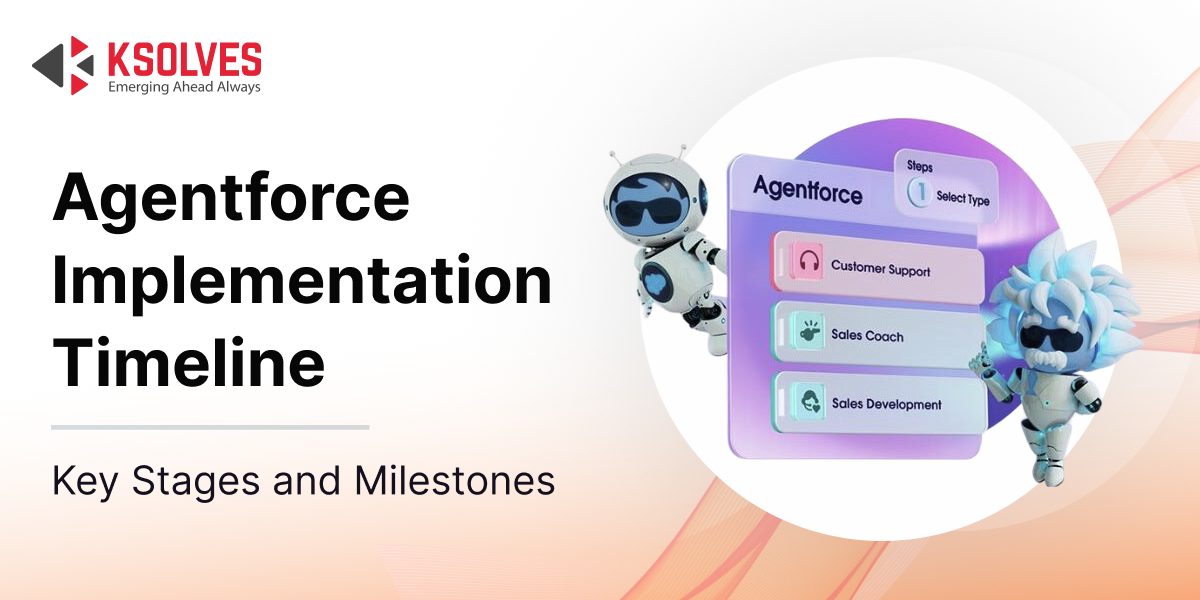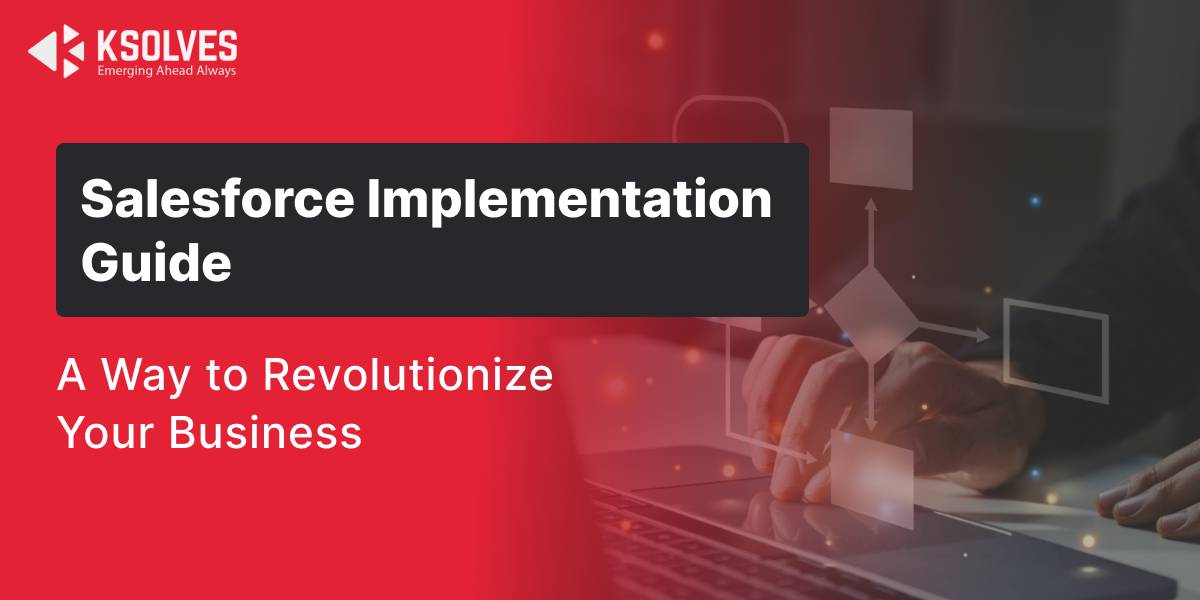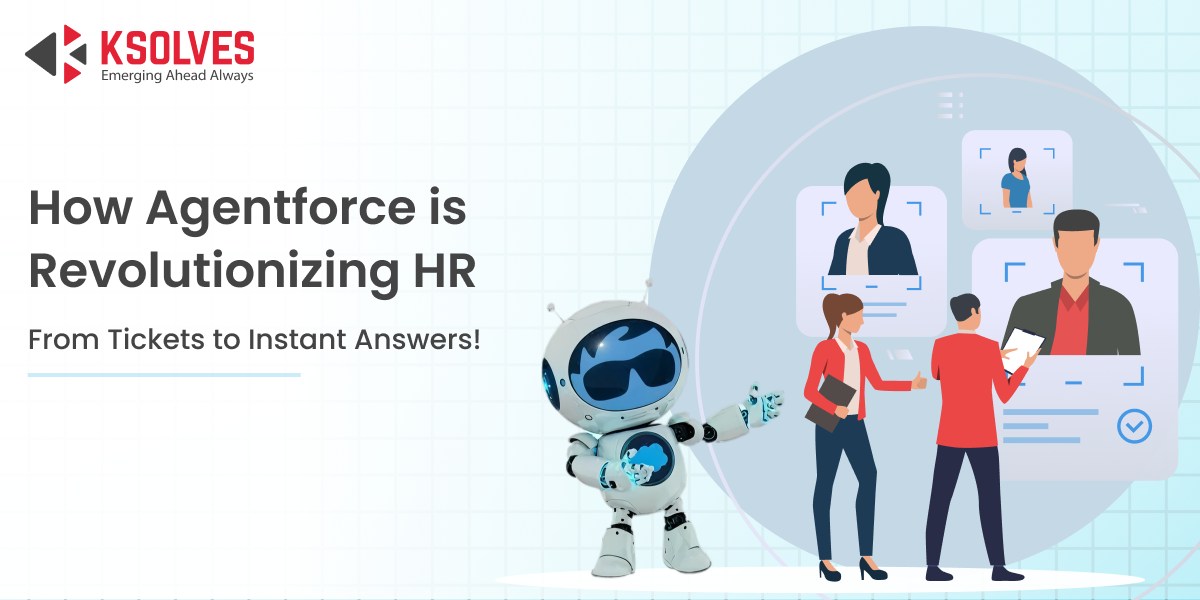Agentforce Implementation Timeline: Key Stages and Milestones
Agentforce
5 MIN READ
June 24, 2025

Salesforce Agentforce is a platform for creating autonomous AI agents that act as digital coworkers. These agents can answer questions, take actions, and handle tasks using business knowledge, providing 24/7 support to employees and customers. By automating repetitive work and delivering always-on assistance, Agentforce boosts efficiency, accuracy, and customer satisfaction. However, adopting AI agents requires careful planning and an agile approach.
Unlike traditional IT projects, AI implementations benefit from starting small (pilots) and iterating based on feedback. This approach minimizes risk while quickly delivering value in short cycles, rather than a single big bang rollout.
Before kicking off an Agentforce project, ensure you have the prerequisites in place. This includes the proper Salesforce licenses (access to Customer 360 and the Agentforce platform) and integration to relevant data sources.
Below is a breakdown of the Agentforce implementation process. Each phase details the key activities, who’s involved, expected deliverables, and how that work impacts your business operations.
Timeline for Agentforce Implementation
Here’s a structured roadmap to help you implement Salesforce Agentforce with confidence. Each phase is designed to build momentum, reduce risk, and ensure a successful AI agent rollout.
Phase 1: Project Kickoff and Alignment
- Key Activities: The project officially launches with a kickoff meeting to establish vision and scope. The team identifies key stakeholders, discusses high-level goals, and outlines use cases the AI agent will tackle.
- Stakeholder Involvement: An executive sponsor and a project manager lead the kickoff. Department heads or business leads whose areas will use the AI agent are engaged to share their needs and commit support. IT and Salesforce platform owners join to assess technical prerequisites.
- Expected Deliverables: The team produces a clear project plan. This typically includes defined project objectives, success metrics, a list of targeted AI use cases, key roles/responsibilities, and a rough timeline.
- Impact on Operations: At this early stage, there is minimal impact on day-to-day operations. Most work is planning and meetings, so apart from the time stakeholders invest in discussions, business as usual continues unaffected. This groundwork ensures all players are aligned and sets the stage for an organized implementation.
Phase 2: Use Case Definition and Requirements
- Key Activities: With leadership backing and scope confirmed, phase 2 focuses on deep discovery. The team runs collaborative workshops to identify and prioritize real-world use cases for the AI agent, such as resolving customer queries, automating data entry, or supporting sales teams with research. For each selected use case, detailed functional requirements are captured.
For instance, what tasks the agent should perform, what knowledge it needs, and how success will be measured. Data sources and system integrations (like CRM records or knowledge bases) are also mapped out. - Stakeholder Involvement: Business process owners and subject-matter experts play a key role in shaping the agent’s responsibilities. They define pain points and critical tasks, while Salesforce admins and AI experts translate those into clear agent capabilities.
- Expected Deliverables: By the end of this phase, the team will have a documented set of use cases, detailed requirements, and defined KPIs. These may be expressed as user stories or process flows. A feature backlog or phased roadmap may also be drafted, especially if multiple use cases are in play.
- Impact on Operations: Operational impact remains minimal, but strategic alignment grows. Stakeholders start visualizing how the agent will support their day-to-day work, laying the groundwork for stronger adoption down the line.
Phase 3: Solution Design and Architecture
- Key Activities: This phase marks the transition from planning to technical design. Salesforce architects and developers create the Agentforce architecture. This includes deciding how the AI agent will operate within Salesforce, what systems it will connect to, and how users will interact with it. The team outlines conversation flows and user interactions, maps integrations like connecting to Salesforce Data Cloud, and sets clear boundaries for what the agent can and cannot do. Governance rules and safety controls are also defined to ensure compliance.
- Stakeholder Involvement: The technical team leads consulting business analysts to validate workflows. Security and compliance teams review the design to ensure the agent’s permissions align with internal policies.
- Expected Deliverables: A detailed solution design document covering system architecture, data flows, conversation logic, and any technical dependencies. This serves as the blueprint for development.
- Impact on Operations: No immediate operational changes, but this phase builds a strong technical foundation that ensures smoother implementation and minimizes risk.
Phase 4: Agent Configuration and Development
- Key Activities: This phase focuses on building the agent in a Salesforce sandbox. Based on the design, the team configures the agent’s topics, actions, and knowledge. They also begin developing any necessary integrations with external systems and start training the agent with relevant content to handle real business scenarios.
- Stakeholder Involvement: The technical team, including Salesforce developers and admins, takes the lead. Subject-matter experts may be consulted to validate content or test early flows. Project managers keep all stakeholders informed of progress.
- Expected Deliverables: By the end of this phase, a basic working version of the Agentforce agent is ready in a test environment. This prototype demonstrates how the agent responds to common use cases and helps validate the development approach.
- Impact on Operations: There is no effect on live systems at this stage. However, having a visible prototype creates excitement and helps stakeholders begin preparing for the rollout phase.
Phase 5: Testing and Iteration
- Key Activities: This stage is all about validating and fine-tuning the AI agent. The team conducts functional and conversational testing to ensure the agent performs tasks correctly, provides accurate responses, and stays within defined boundaries. Using Salesforce’s Agentforce Testing Center, they simulate interactions at scale to identify bugs, unclear prompts, or unexpected behaviors. The agent is then refined through several test-fix cycles to improve performance and reliability.
- Stakeholder Involvement: QA analysts and Salesforce admins lead the testing. Select business users, such as service agents or sales reps, may be invited to try out the agent in controlled environments and share practical feedback to enhance usability. A technical report is also discussed to identify and prioritize the next crucial improvements based on testing outcomes and user input.
- Expected Deliverables: The team delivers a refined “beta” version of the agent along with a testing report. This includes fixed issues, remaining bugs, and feedback from pilot users that have been incorporated into the configuration.
- Impact on Operations: Minimal disruption, as testing happens in a sandbox or with a small user group. However, this phase plays a key role in ensuring the agent is reliable before go-live. It also builds internal trust, turning early testers into advocates for broader adoption.
Phase 6: User Training and User Acceptance Testing (UAT)
- Key Activities: The nearly finalized AI agent is introduced to a wider group of users. The team hosts training sessions or demos to familiarize users, like call center agents or sales reps, with how to use the agent effectively. Simultaneously, User Acceptance Testing (UAT) is conducted, where business users interact with the agent in real-world scenarios. Final tweaks, such as refining phrasing or adding overlooked FAQs, are captured and implemented.
- Stakeholder Involvement:
Business end-users take center stage during this stage. Training leads manage sessions, while project admins and developers support testing and address any issues. Executive sponsors may participate to show endorsement and boost morale. - Expected Deliverables: The team delivers a completed round of User Acceptance Testing (UAT) with documented feedback, a formal UAT sign-off from business stakeholders, and finalized user training materials. This includes updated user guides, FAQs, and any last-minute adjustments made to improve agent usability or response quality based on test scenarios.
- Impact on Operations: Minimal. Users spend a small amount of time on training. This investment pays off in smooth adoption later. Anticipation starts building across teams as the agent nears production use.
Phase 7: Pilot Launch (Limited Deployment)
- Key Activities: The AI agent goes live in a controlled setting—for example, one department or regional office. The project team monitors real-world performance, collecting metrics like resolution rate and user satisfaction. Feedback is gathered through scheduled check-ins, and any issues are addressed quickly. This low-risk rollout helps validate technical and user experience aspects.
- Stakeholder Involvement: The pilot group becomes the primary focus. They’re encouraged to use the agent in daily tasks and provide feedback. The project team stays hands-on to support and refine in real time. Leadership monitors progress closely to inform the full deployment decision.
- Expected Deliverables: The experts deliver a detailed pilot performance report. This includes agent usage metrics, success rates, user feedback, and any technical issues encountered. Minor improvements made during the pilot are documented, along with a recommendation on whether the agent is ready to scale.
- Impact on Operations: Moderate but contained. Pilot users integrate the agent into their workflows, seeing early productivity benefits. Broader operations remain unaffected, allowing safe learning and adjustment before scaling.
Phase 8: Evaluation and Optimization
- Key Activities: Post-pilot, the team evaluates performance against predefined success metrics. They review data and user feedback to identify areas of improvement. Optimizations may include enhancing knowledge content, refining escalation logic, or improving integrations. A leadership go/no-go meeting is held to determine readiness for full rollout.
- Stakeholder Involvement: Business leaders, pilot users, and technical teams collaborate closely. Project sponsors weigh in on strategic fit and results. Developers implement any final tweaks based on findings.
- Expected Deliverables: The team delivers a comprehensive evaluation report summarizing pilot outcomes against defined success metrics. This includes updated agent configurations reflecting optimizations, a documented list of improvements implemented post-pilot, and a formal recommendation to proceed (or not) with full deployment. A draft rollout plan is also prepared to support the next steps.
- Impact on Operations: Still limited to pilot users. Any rough edges are smoothed out, ensuring broader rollout will be stable and effective. This phase builds executive confidence and ensures readiness.
Phase 9: Full Rollout Planning
- Key Activities: With the green light, the team prepares for organization-wide deployment. This includes finalizing the rollout strategy (phased or all-at-once), scaling the environment, and updating communications and training materials. Helpdesk and support processes are formalized. Everyone involved is briefed on their roles.
- Stakeholder Involvement: Project managers coordinate across departments. Change managers handle user communications and training plans. Leaders approve timing and share messaging to generate excitement and alignment.
- Expected Deliverables: The team gives a finalized rollout strategy and schedule, updated training materials for remaining users, and a support readiness plan including help desk documentation and escalation procedures. Communication assets (e.g., internal emails, announcements) are also completed, and all departments involved are aligned and briefed on their roles for go-live.
- Impact on Operations: Minimal operational change in this phase. Internal communications might create awareness and readiness, but the major impact begins with go-live.
Phase 10: Go-Live and Full Deployment
- Key Activities: The Agentforce agent is fully deployed to all intended users. The team performs any final data updates, flips the switch in production, and provides real-time support. They monitor metrics, user activity, and emerging issues. Immediate fixes are applied as needed. Early usage stats are tracked closely.
- Stakeholder Involvement: All users are now active participants. The support team is on high alert to respond swiftly. Leaders continue communicating the agent’s benefits to encourage adoption and ease transitions. If the agent is customer-facing, service teams monitor the customer experience closely.
- Expected Deliverables: The team provides a successful full-scale deployment of the AI agent, with documented go-live performance metrics and a daily issue resolution log. A post-launch retrospective is conducted, and key lessons learned are captured. The project can formally close the implementation phase, transitioning into a steady-state support model.
- Impact on Operations: Significant and visible. The AI agent becomes part of everyday workflows, handling tasks like data lookups, customer queries, or task routing. Some users may need adjustment time, but training and pilot phases reduce disruption. Productivity gains start materializing almost immediately.
[Also Read: Salesforce Agentforce vs. Traditional Support: Is It A Game Changer]
Conclusion
Implementing Salesforce Agentforce is more than just a tech upgrade—it’s a smart step toward making your business faster, smarter, and more efficient. A phase-by-phase approach helps reduce risk, improve results, and keep everyone aligned as you roll out AI agents. Each phase builds on the last to ensure a smooth and successful launch.
Ksolves, a trusted Salesforce Summit Partner, is here to guide you through the entire journey. From planning and setup to training and support, we help you get the most out of Agentforce. With Ksolves by your side, your AI agents can become reliable digital coworkers, working 24/7 to support your teams and improve customer experiences. So, contact us today for Agentforce consulting services.







Author
Share with